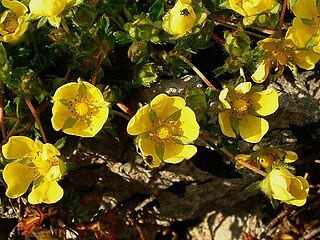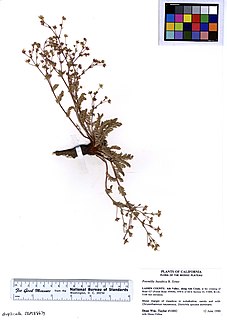
Potentilla is a genus containing over 300 species of annual, biennial and perennial herbaceous flowering plants in the rose family, Rosaceae.

Dasiphora fruticosa is a species of hardy deciduous flowering shrub in the family Rosaceae, native to the cool temperate and subarctic regions of the northern hemisphere, often growing at high altitudes in mountains. Dasiphora fruticosa is a disputed name, and the plant is still widely referenced in the horticultural literature under its synonym Potentilla fruticosa. Common names include shrubby cinquefoil, golden hardhack, bush cinquefoil, shrubby five-finger, widdy, and kuril tea.

Potentilla neumanniana, the spring cinquefoil or spotted cinquefoil, is a perennial flowering plant in the rose family (Rosaceae). It may grow up to the height of 5–15 cm.

The Pilot Range is a mountain range straddling the border of Box Elder County, Utah and Elko County, Nevada, United States. Lying 50 miles west of the Great Salt Lake, the range forms part of the north-west border of the Great Salt Lake Desert. The range reaches a maximum elevation of 10,716 feet at the summit of Pilot Peak. Most of the range is public Bureau of Land Management land and thus has no access restrictions. Its principal uses are mining, livestock grazing, and seasonal elk and deer hunting.

Potentilla recta, the sulphur cinquefoil or rough-fruited cinquefoil, is a species of cinquefoil. It is native to Eurasia but it is present in North America as an introduced species, ranging through almost the entire continent except the northernmost part of Canada and Alaska.

Potentilla diversifolia or Potentilla × diversifolia is a species of flowering plant in the Rose Family (Rosaceae) known by the common names varileaf cinquefoil, different-leaved cinquefoil, and mountain meadow cinquefoil.
Potentilla grayi is a species of cinquefoil known by the common name Gray's cinquefoil.
Potentilla millefolia is a species of cinquefoil known by the common names cutleaf cinquefoil and feather cinquefoil. It is native to Oregon, Nevada and eastern California, where it grows in moist mountain meadows and similar habitat. The plant produces a basal rosette from a taproot, then a decumbent stem up to about 20 centimeters in maximum length. The elongated leaves are made up of several overlapping pairs of deeply lobed leaflets. The inflorescence at the tip of the stem is a cyme of a few flowers, each with usually five yellow petals under a centimeter long.

Potentilla norvegica is a species of cinquefoil known by the common names rough cinquefoil, ternate-leaved cinquefoil, and Norwegian cinquefoil. It is native to Europe, Asia, and parts of North America, and it can be found elsewhere as an introduced species.
Potentilla pseudosericea is a species of cinquefoil known by the common names silky cinquefoil and Mono cinquefoil. It is native to the Sierra Nevada of California and mountain ranges just to the east, where its distribution extends into Nevada. It grows in rocky mountainous habitat. It is a small plant forming mats or tufts in rock cracks and talus, its short stem growing from a caudex. The leaves are generally palmate, divided into five leaflets. The leaflets are deeply lobed along the edges and woolly in texture, coated in white or silvery hairs. The inflorescence is a cluster of a few yellow flowers with petals around 3 millimeters long each.
Potentilla rimicola is a species of cinquefoil-Potentilla, known by the common name cliff cinquefoil.
Potentilla wheeleri is a species of cinquefoil known by the common name Kern cinquefoil or Wheeler's cinquefoil. It is native to the Sierra Nevada and nearby ranges of California and it has been reported from Arizona and Baja California. Its habitat includes moist areas in mountainous regions. This tuftlike plant produces spreading, decumbent stems with leaves sometimes arranged in a rosette about the caudex. The hairy stems reach a maximum length near 25 centimeters. The rough-haired leaves are palmate, each divided into five wedge-shaped leaflets which are lined or tipped with teeth. The inflorescence is a cyme of several flowers with yellow petals each a few millimeters long.

Potentilla villosa is a species of flowering plant in the rose family, Rosaceae. Its common names include villous cinquefoil, northern cinquefoil, and hairy cinquefoil. It is native to northwestern North America, where its distribution extends from Alaska to Alberta to Oregon. There are records from eastern Asia.

Astragalus montii is a rare species of flowering plant in the legume family known by the common name heliotrope milkvetch. It is endemic to Utah in the United States, where there are only three known populations. It is a federally listed threatened species of the United States. This species is often treated as a variety of Astragalus limnocharis.
Potentilla angelliae is a rare species of flowering plant in the rose family known by the common names Angell cinquefoil and Boulder Mountain cinquefoil. It is endemic to Utah in the United States, where it is known only from Boulder Mountain on the Aquarius Plateau.
Potentilla johnstonii is a rare species of flowering plant in the rose family known by the common name sagebrush cinquefoil. It is native to Nevada, where it has been collected from only one spot in the Quinn Canyon Range of Nye County.
Primula capillaris is a rare species of flowering plant in the primrose family known by the common name Ruby Mountains primrose, or Ruby Mountain primrose. It is endemic to Nevada in the United States, where it is limited to the Ruby Mountains of Elko County.

Cirsium eatonii, commonly known as Eaton's thistle or mountaintop thistle, is a North American species of flowering plants in the aster family.

Potentilla basaltica is a species of flowering plant in the rose family known by the common names Soldier Meadows cinquefoil and basalt cinquefoil. It is endemic to a small area of the Modoc Plateau and Warner Mountains in northeastern California and northwestern Nevada.

Potentilla simplex, also known as common cinquefoil or old-field five-fingers or oldfield cinquefoil, is a perennial herb in the Rosaceae (rose) family native to eastern North America from Ontario, Quebec, and Labrador south to Texas, Alabama, and panhandle Florida.












